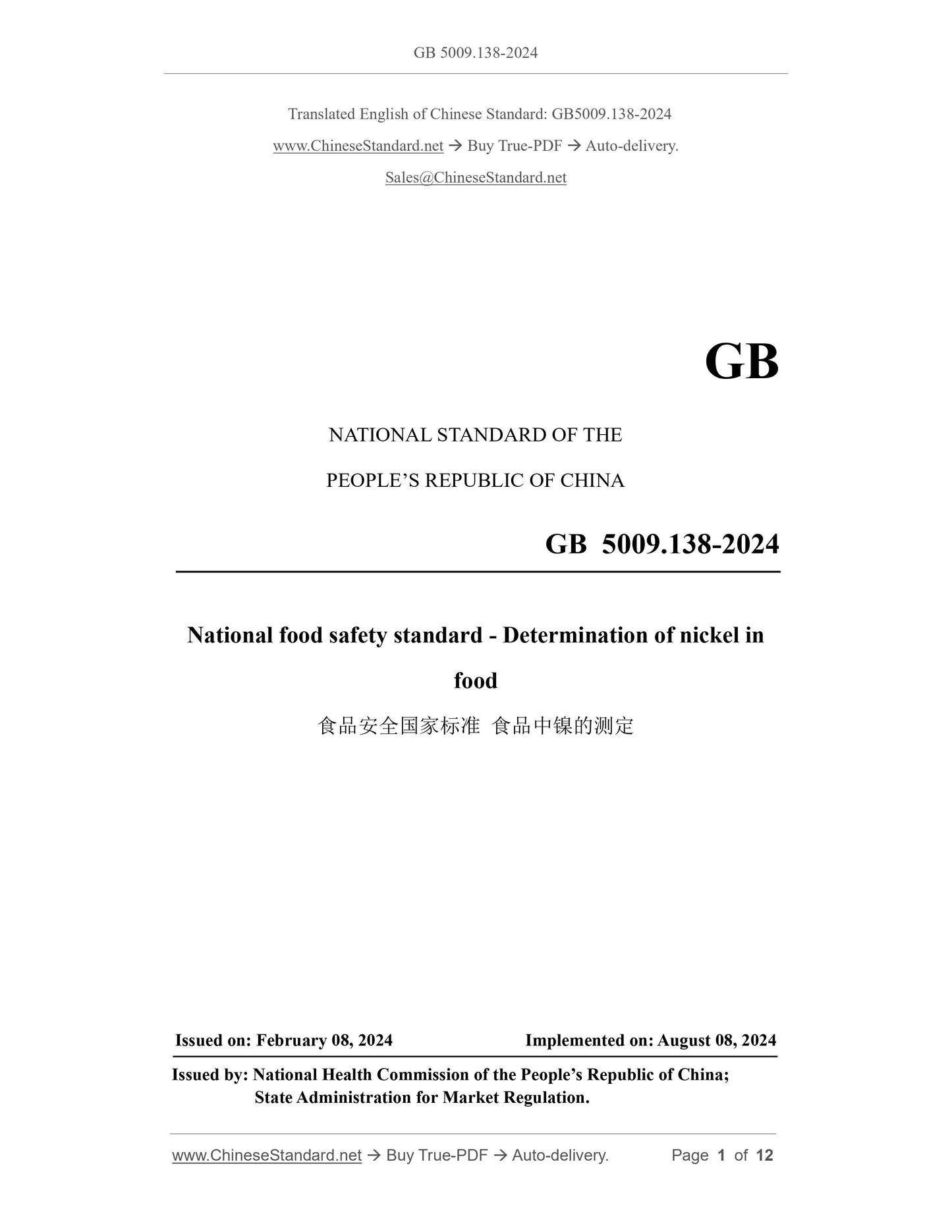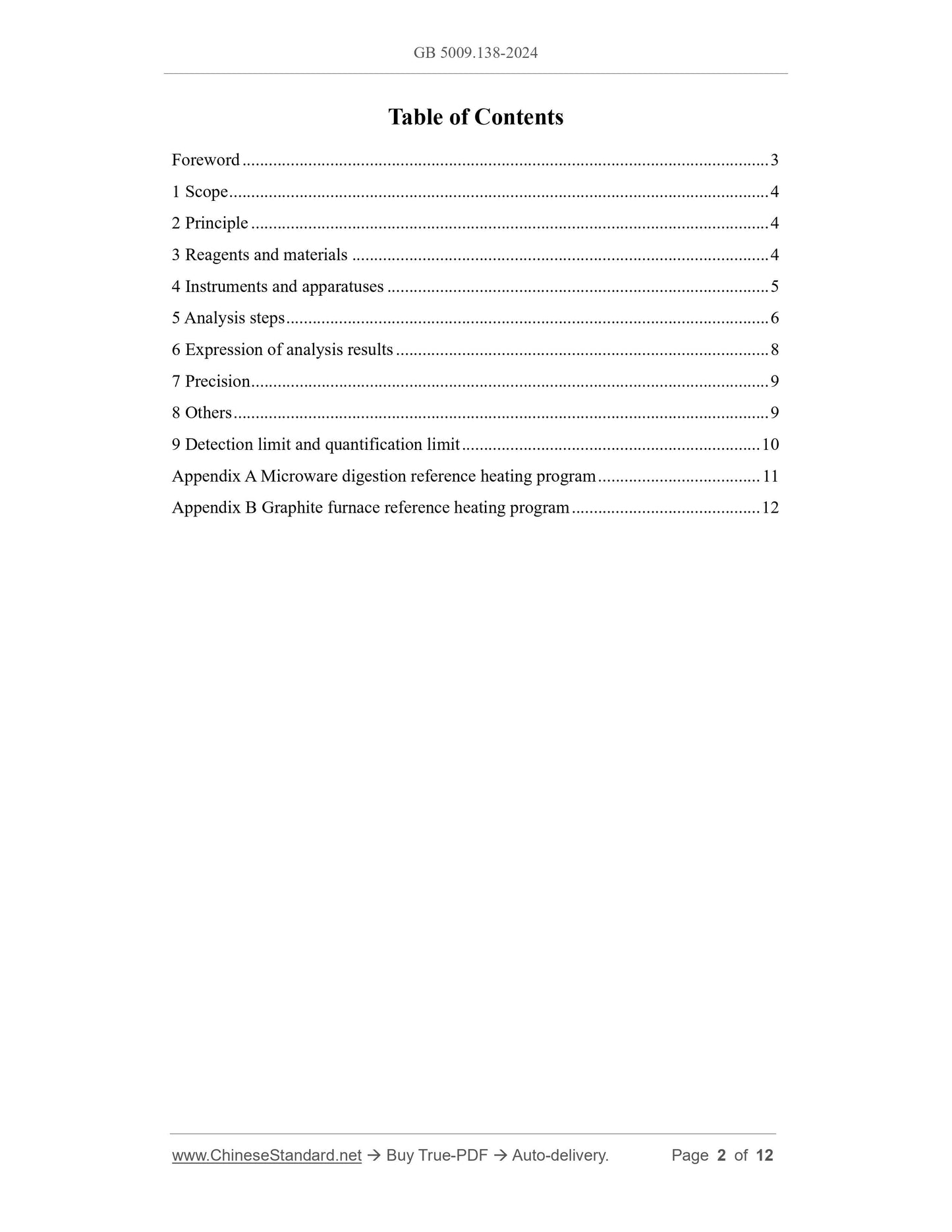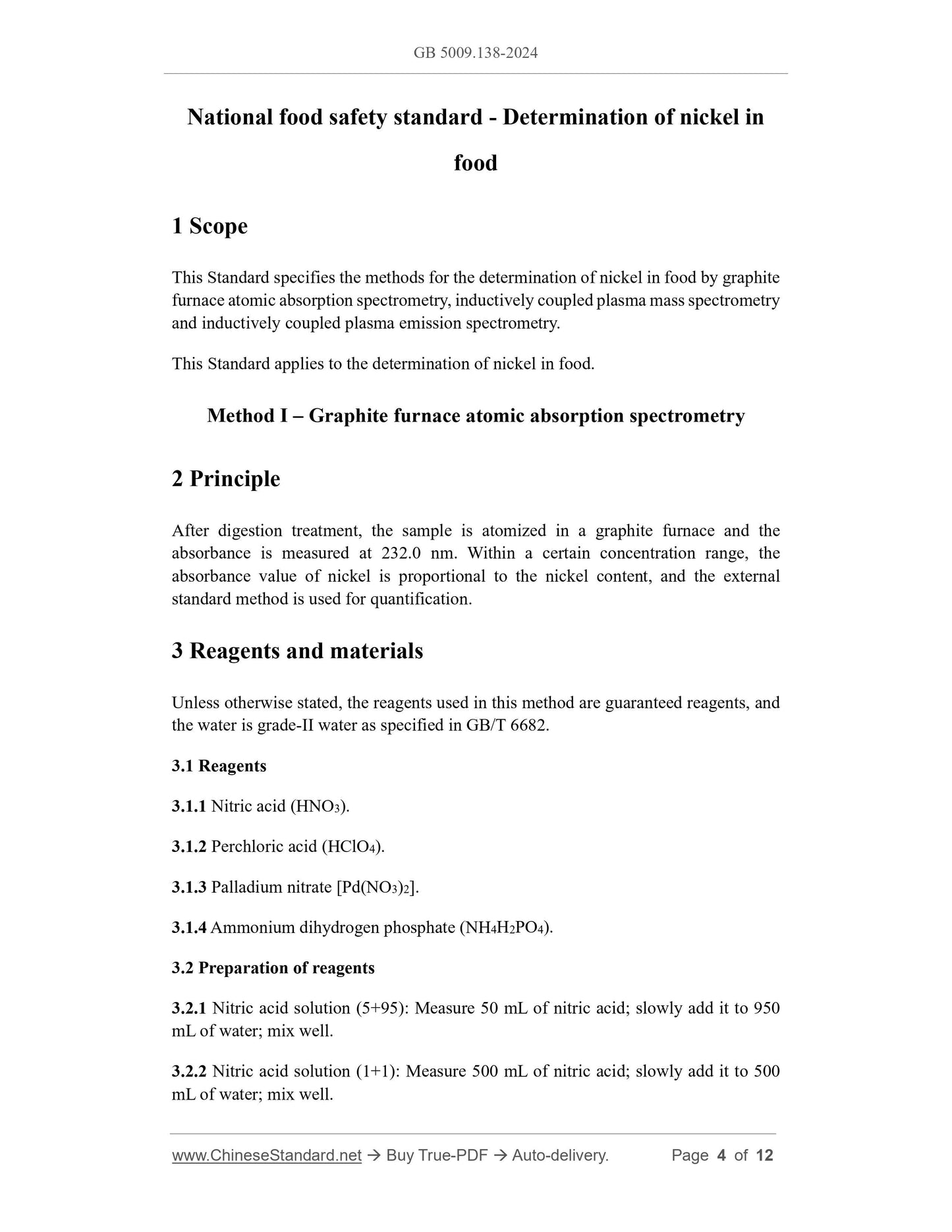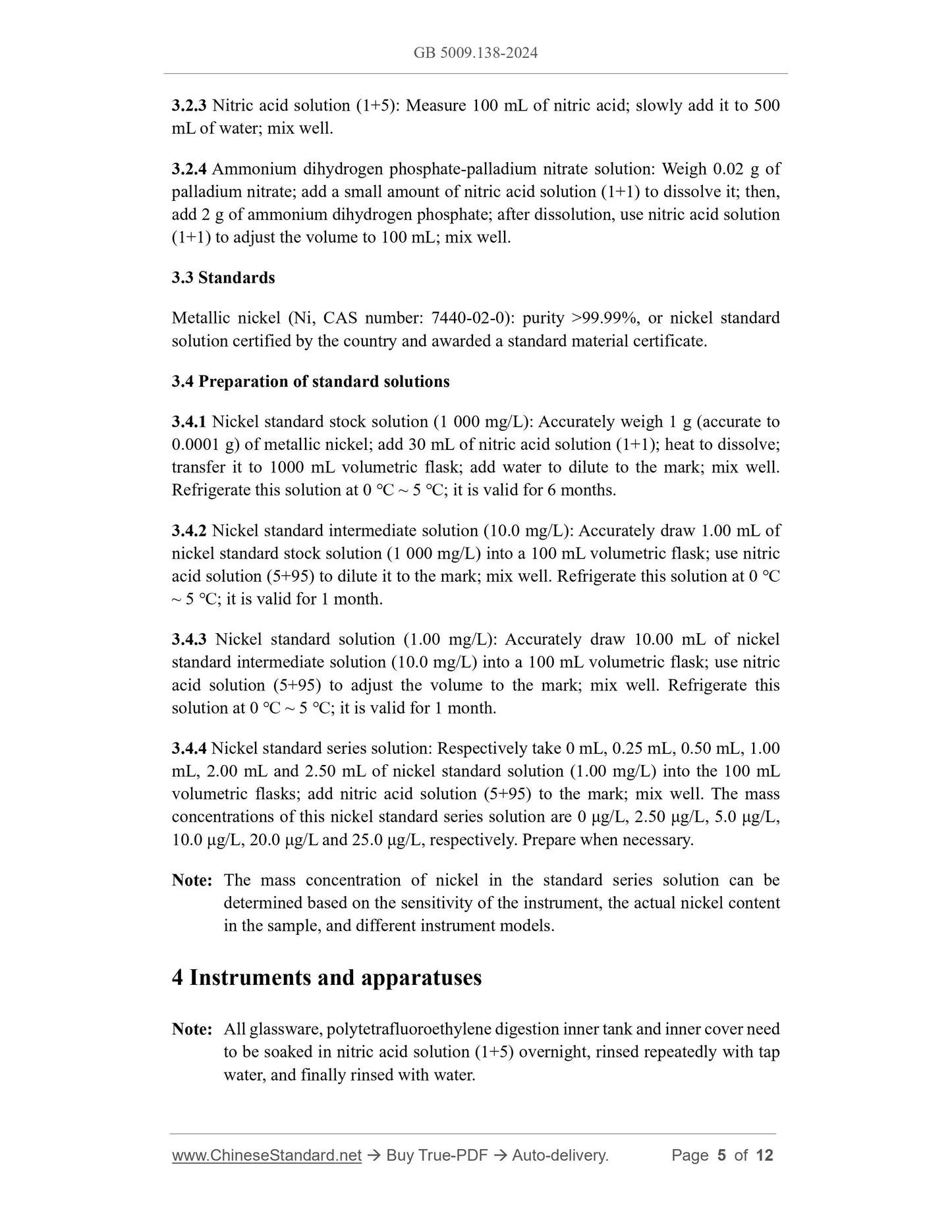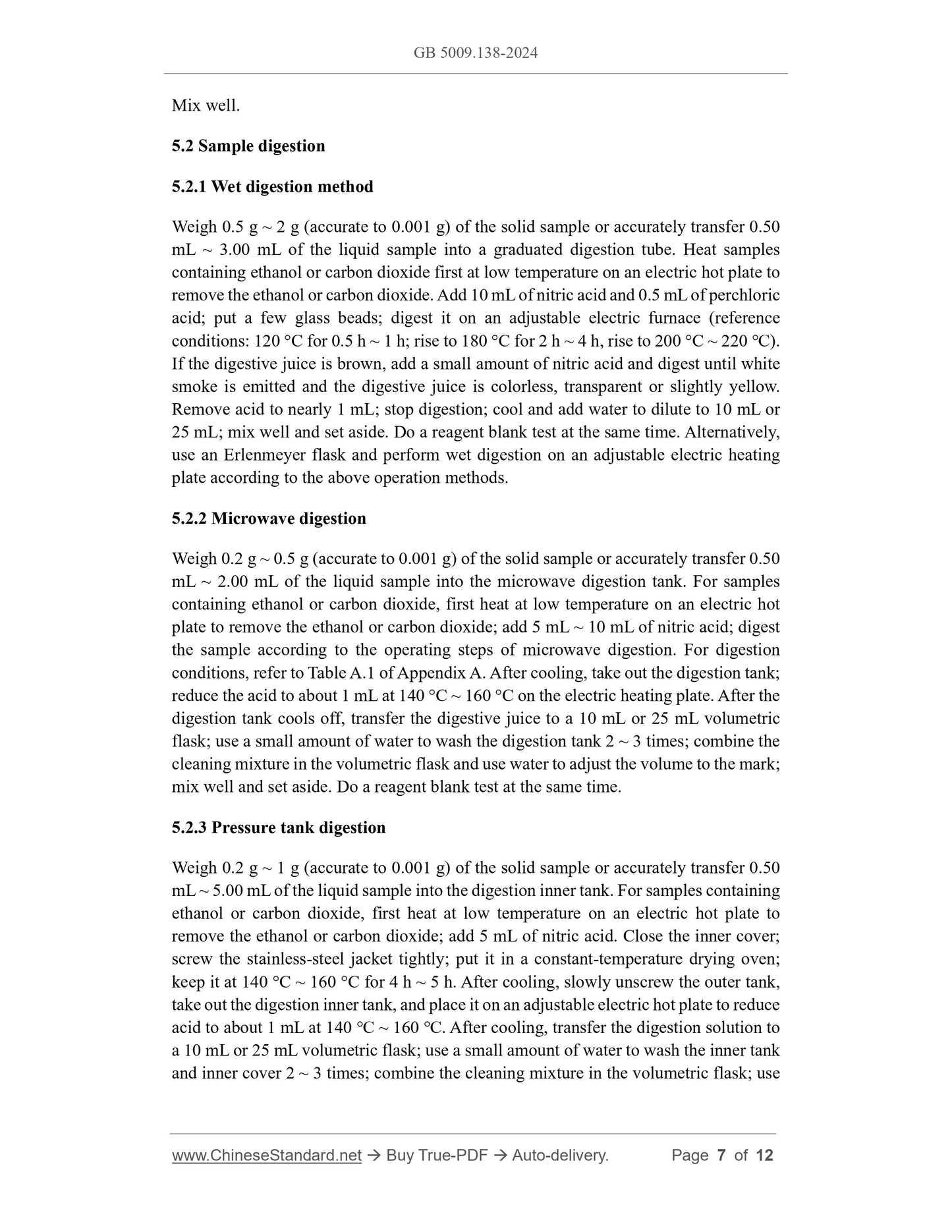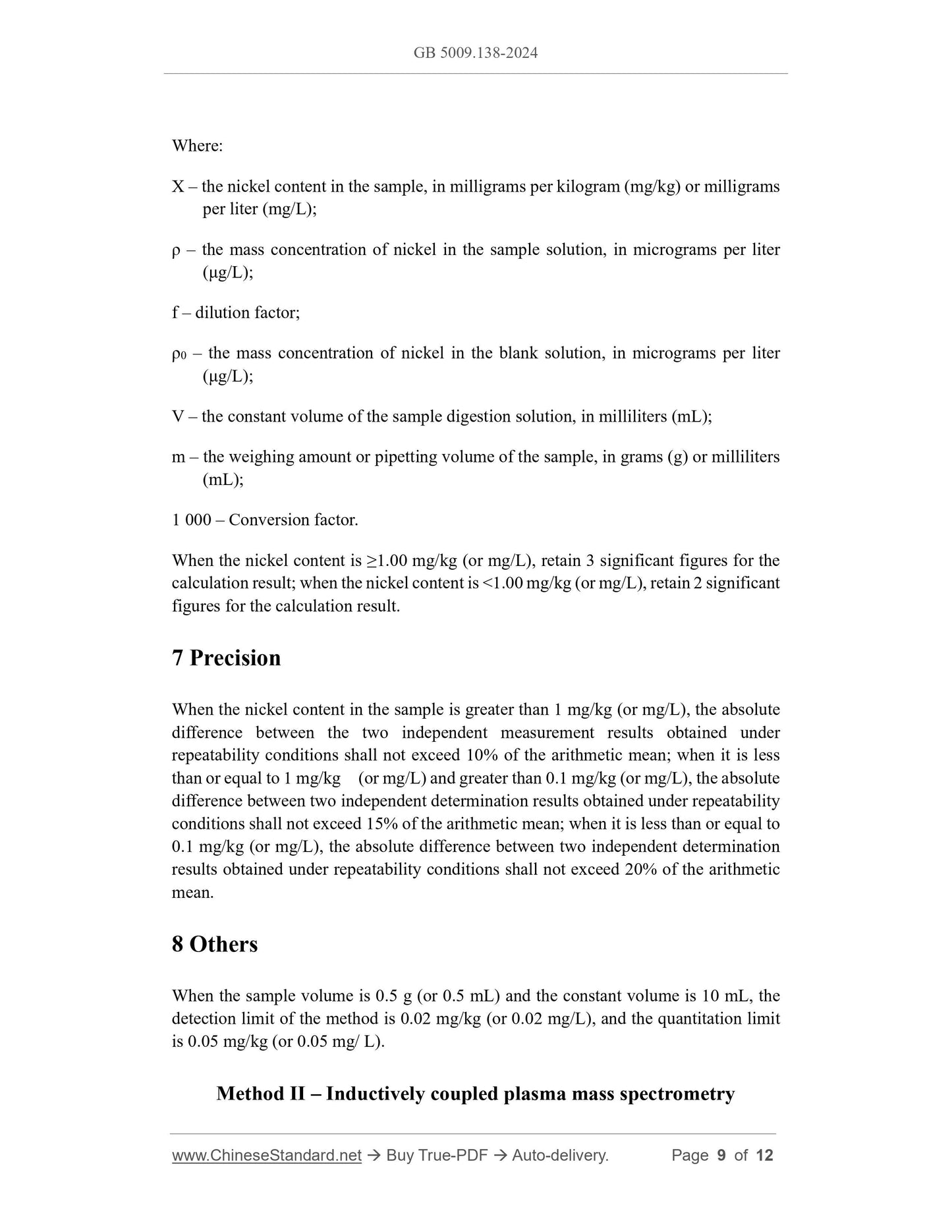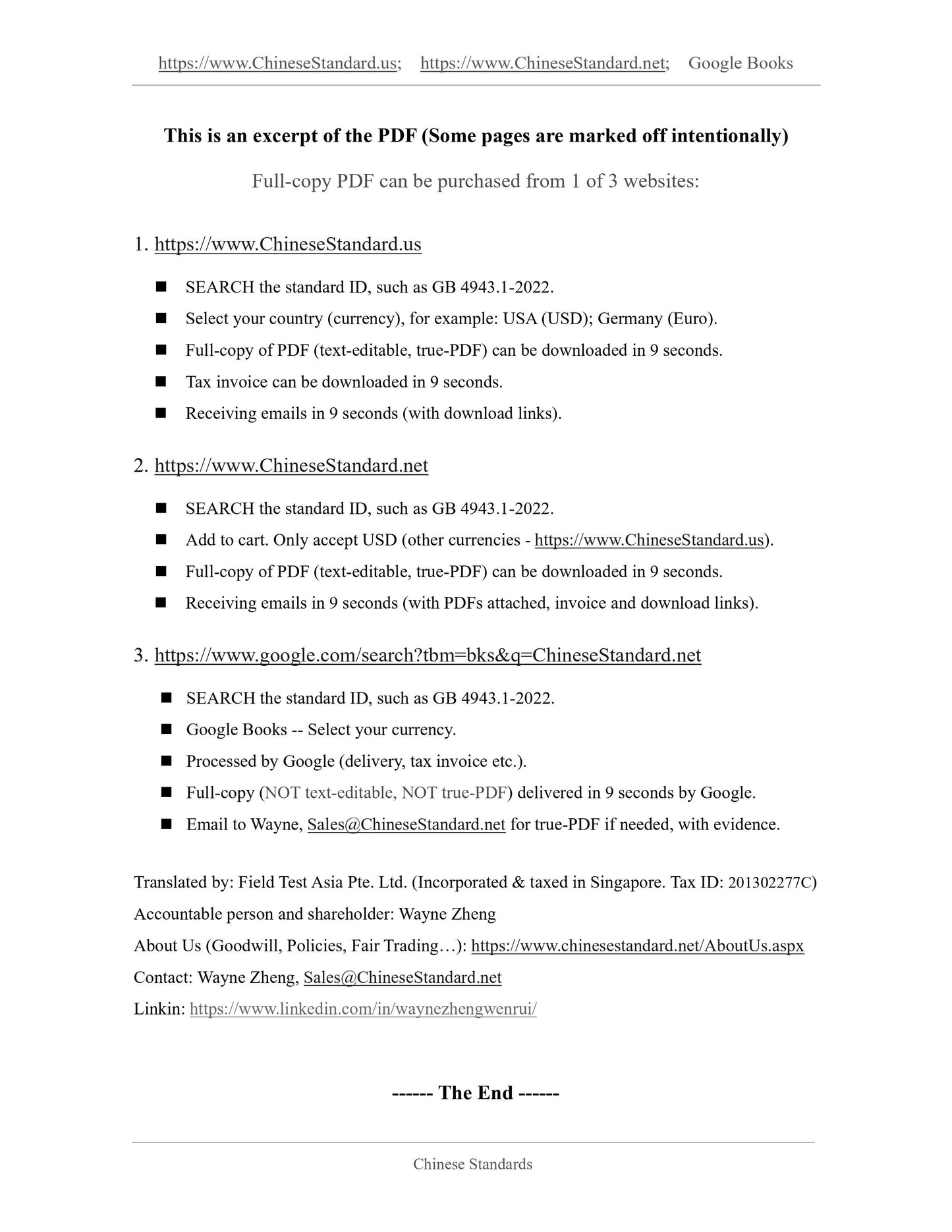1
/
of
7
www.ChineseStandard.us -- Field Test Asia Pte. Ltd.
GB 5009.138-2024 English PDF
GB 5009.138-2024 English PDF
Regular price
$185.00
Regular price
Sale price
$185.00
Unit price
/
per
Shipping calculated at checkout.
Couldn't load pickup availability
GB 5009.138-2024: National food safety standard - Determination of nickel in food
Delivery: 9 seconds. Download (& Email) true-PDF + Invoice.
Get Quotation: Click GB 5009.138-2024 (Self-service in 1-minute)
Historical versions (Master-website): GB 5009.138-2024
Preview True-PDF (Reload/Scroll-down if blank)
GB 5009.138-2024
GB
NATIONAL STANDARD OF THE
PEOPLE’S REPUBLIC OF CHINA
National food safety standard - Determination of nickel in
food
ISSUED ON: FEBRUARY 08, 2024
IMPLEMENTED ON: AUGUST 08, 2024
Issued by: National Health Commission of the People’s Republic of China;
State Administration for Market Regulation.
Table of Contents
Foreword ... 3
1 Scope ... 4
2 Principle ... 4
3 Reagents and materials ... 4
4 Instruments and apparatuses ... 5
5 Analysis steps ... 6
6 Expression of analysis results ... 8
7 Precision ... 9
8 Others ... 9
9 Detection limit and quantification limit ... 10
Appendix A Microware digestion reference heating program ... 11
Appendix B Graphite furnace reference heating program ... 12
National food safety standard - Determination of nickel in
food
1 Scope
This Standard specifies the methods for the determination of nickel in food by graphite
furnace atomic absorption spectrometry, inductively coupled plasma mass spectrometry
and inductively coupled plasma emission spectrometry.
This Standard applies to the determination of nickel in food.
Method I – Graphite furnace atomic absorption spectrometry
2 Principle
After digestion treatment, the sample is atomized in a graphite furnace and the
absorbance is measured at 232.0 nm. Within a certain concentration range, the
absorbance value of nickel is proportional to the nickel content, and the external
standard method is used for quantification.
3 Reagents and materials
Unless otherwise stated, the reagents used in this method are guaranteed reagents, and
the water is grade-II water as specified in GB/T 6682.
3.1 Reagents
3.1.1 Nitric acid (HNO3).
3.1.2 Perchloric acid (HClO4).
3.1.3 Palladium nitrate [Pd(NO3)2].
3.1.4 Ammonium dihydrogen phosphate (NH4H2PO4).
3.2 Preparation of reagents
3.2.1 Nitric acid solution (5+95): Measure 50 mL of nitric acid; slowly add it to 950
mL of water; mix well.
3.2.2 Nitric acid solution (1+1): Measure 500 mL of nitric acid; slowly add it to 500
mL of water; mix well.
3.2.3 Nitric acid solution (1+5): Measure 100 mL of nitric acid; slowly add it to 500
mL of water; mix well.
3.2.4 Ammonium dihydrogen phosphate-palladium nitrate solution: Weigh 0.02 g of
palladium nitrate; add a small amount of nitric acid solution (1+1) to dissolve it; then,
add 2 g of ammonium dihydrogen phosphate; after dissolution, use nitric acid solution
(1+1) to adjust the volume to 100 mL; mix well.
3.3 Standards
Metallic nickel (Ni, CAS number: 7440-02-0): purity >99.99%, or nickel standard
solution certified by the country and awarded a standard material certificate.
3.4 Preparation of standard solutions
3.4.1 Nickel standard stock solution (1 000 mg/L): Accurately weigh 1 g (accurate to
0.0001 g) of metallic nickel; add 30 mL of nitric acid solution (1+1); heat to dissolve;
transfer it to 1000 mL volumetric flask; add water to dilute to the mark; mix well.
Refrigerate this solution at 0 ℃ ~ 5 ℃; it is valid for 6 months.
3.4.2 Nickel standard intermediate solution (10.0 mg/L): Accurately draw 1.00 mL of
nickel standard stock solution (1 000 mg/L) into a 100 mL volumetric flask; use nitric
acid solution (5+95) to dilute it to the mark; mix well. Refrigerate this solution at 0 ℃
~ 5 ℃; it is valid for 1 month.
3.4.3 Nickel standard solution (1.00 mg/L): Accurately draw 10.00 mL of nickel
standard intermediate solution (10.0 mg/L) into a 100 mL volumetric flask; use nitric
acid solution (5+95) to adjust the volume to the mark; mix well. Refrigerate this
solution at 0 ℃ ~ 5 ℃; it is valid for 1 month.
3.4.4 Nickel standard series solution: Respectively take 0 mL, 0.25 mL, 0.50 mL, 1.00
mL, 2.00 mL and 2.50 mL of nickel standard solution (1.00 mg/L) into the 100 mL
volumetric flasks; add nitric acid solution (5+95) to the mark; mix well. The mass
concentrations of this nickel standard series solution are 0 μg/L, 2.50 μg/L, 5.0 μg/L,
10.0 μg/L, 20.0 μg/L and 25.0 μg/L, respectively. Prepare when necessary.
Note: The mass concentration of nickel in the standard series solution can be
determined based on the sensitivity of the instrument, the actual nickel content
in the sample, and different instrument models.
4 Instruments and apparatuses
Note: All glassware, polytetrafluoroethylene digestion inner tank and inner cover need
to be soaked in nitric acid solution (1+5) overnight, rinsed repeatedly with tap
water, and finally rinsed with water.
Mix well.
5.2 Sample digestion
5.2.1 Wet digestion method
Weigh 0.5 g ~ 2 g (accurate to 0.001 g) of the solid sample or accurately transfer 0.50
mL ~ 3.00 mL of the liquid sample into a graduated digestion tube. Heat samples
containing ethanol or carbon dioxide first at low temperature on an electric hot plate to
remove the ethanol or carbon dioxide. Add 10 mL of nitric acid and 0.5 mL of perchloric
acid; put a few glass beads; digest it on an adjustable electric furnace (reference
conditions: 120 °C for 0.5 h ~ 1 h; rise to 180 °C for 2 h ~ 4 h, rise to 200 °C ~ 220 ℃).
If the digestive juice is brown, add a small amount of nitric acid and digest until white
smoke is emitted and the digestive juice is colorless, transparent or slightly yellow.
Remove acid to nearly 1 mL; stop digestion; cool and add water to dilute to 10 mL or
25 mL; mix well and set aside. Do a reagent blank test at the same time. Alternatively,
use an Erlenmeyer flask and perform wet digestion on an adjustable electric heating
plate according to the above operation methods.
5.2.2 Microwave digestion
Weigh 0.2 g ~ 0.5 g (accurate to 0.001 g) of the solid sample or accurately transfer 0.50
mL ~ 2.00 mL of the liquid sample into the microwave digestion tank. For samples
containing ethanol or carbon dioxide, first heat at low temperature on an electric hot
plate to remove the ethanol or carbon dioxide; add 5 mL ~ 10 mL of nitric acid; digest
the sample according to the operating steps of microwave digestion. For digestion
conditions, refer to Table A.1 of Appendix A. After cooling, take out the digestion tank;
reduce the acid to about 1 mL at 140 °C ~ 160 °C on the electric heating plate. After the
digestion tank cools off, transfer the digestive juice to a 10 mL or 25 mL volumetric
flask; use a small amount of water to wash the digestion tank 2 ~ 3 times; combine the
cleaning mixture in the volumetric flask and use water to adjust the volume to the mark;
mix well and set aside. Do a reagent blank test at the same time.
5.2.3 Pressure tank digestion
Weigh 0.2 g ~ 1 g (accurate to 0.001 g) of the solid sample or accurately transfer 0.50
mL ~ 5.00 mL of the liquid sample into the digestion inner tank. For samples containing
ethanol or carbon dioxide, first heat at low temperature on an electric hot plate to
remove the ethanol or carbon dioxide; add 5 mL of nitric acid. Close the inner cover;
screw the stainless-steel jacket tightly; put it in a constant-temperature drying oven;
keep it at 140 °C ~ 160 °C for 4 h ~ 5 h. After cooling, slowly unscrew the outer tank,
take out the digestion inner tank, and place it on an adjustable electric hot plate to reduce
acid to about 1 mL at 140 ℃ ~ 160 ℃. After cooling, transfer the digestion solution to
a 10 mL or 25 mL volumetric flask; use a small amount of water to wash the inner tank
and inner cover 2 ~ 3 times; combine the cleaning mixture in the volumetric flask; use
Where:
X – the nickel content in the sample, in milligrams per kilogram (mg/kg) or milligrams
per liter (mg/L);
ρ – the mass concentration of nickel in the sample solution, in micrograms per liter
(μg/L);
f – dilution factor;
ρ0 – the mass concentration of nickel in the blank solution, in micrograms per liter
(μg/L);
V – the constant volume of the sample digestion solution, in milliliters (mL);
m – the weighing amount or pipetting volume of the sample, in grams (g) or milliliters
(mL);
1 000 – Conversion factor.
When the nickel content is ≥1.00 mg/kg (or mg/L), retain 3 significant figures for the
calculation result; when the nickel content is < 1.00 mg/kg (or mg/L), retain 2 significant
figures for the calculation result.
7 Precision
When the nickel content in the sample is greater than 1 mg/kg (or mg/L), the absolute
difference between the two independent measurement results obtained under
repeatability conditions shall not exceed 10% of the arithmetic mean; when it is less
than or equal to 1 mg/kg (or mg/L) and greater than 0.1 mg/kg (or mg/L), the absolute
difference between two independent determination results obtained under repeatability
conditions shall not exceed 15% of the arithmetic mean; when it is less than or equal to
0.1 mg/kg (or mg/L), the absolute difference between two independent determination
results obtained under repeatability conditions shall not exceed 20% of the arithmetic
mean.
8 Others
When the sample volume is 0.5 g (or 0.5 mL) and the constant volume is 10 mL, the
detection limit of the method is 0.02 mg/kg (or 0.02 mg/L), and the quantitation limit
is 0.05 mg/kg (or 0.05 mg/ L).
Method II – Inductively coupled plasma mass spectrometry
GB 5009.138-2024
GB
NATIONAL STANDARD OF THE
PEOPLE’S REPUBLIC OF CHINA
National food safety standard - Determination of nickel in
food
ISSUED ON: FEBRUARY 08, 2024
IMPLEMENTED ON: AUGUST 08, 2024
Issued by: National Health Commission of the People’s Republic of China;
State Administration for Market Regulation.
Table of Contents
Foreword ... 3
1 Scope ... 4
2 Principle ... 4
3 Reagents and materials ... 4
4 Instruments and apparatuses ... 5
5 Analysis steps ... 6
6 Expression of analysis results ... 8
7 Precision ... 9
8 Others ... 9
9 Detection limit and quantification limit ... 10
Appendix A Microware digestion reference heating program ... 11
Appendix B Graphite furnace reference heating program ... 12
National food safety standard - Determination of nickel in
food
1 Scope
This Standard specifies the methods for the determination of nickel in food by graphite
furnace atomic absorption spectrometry, inductively coupled plasma mass spectrometry
and inductively coupled plasma emission spectrometry.
This Standard applies to the determination of nickel in food.
Method I – Graphite furnace atomic absorption spectrometry
2 Principle
After digestion treatment, the sample is atomized in a graphite furnace and the
absorbance is measured at 232.0 nm. Within a certain concentration range, the
absorbance value of nickel is proportional to the nickel content, and the external
standard method is used for quantification.
3 Reagents and materials
Unless otherwise stated, the reagents used in this method are guaranteed reagents, and
the water is grade-II water as specified in GB/T 6682.
3.1 Reagents
3.1.1 Nitric acid (HNO3).
3.1.2 Perchloric acid (HClO4).
3.1.3 Palladium nitrate [Pd(NO3)2].
3.1.4 Ammonium dihydrogen phosphate (NH4H2PO4).
3.2 Preparation of reagents
3.2.1 Nitric acid solution (5+95): Measure 50 mL of nitric acid; slowly add it to 950
mL of water; mix well.
3.2.2 Nitric acid solution (1+1): Measure 500 mL of nitric acid; slowly add it to 500
mL of water; mix well.
3.2.3 Nitric acid solution (1+5): Measure 100 mL of nitric acid; slowly add it to 500
mL of water; mix well.
3.2.4 Ammonium dihydrogen phosphate-palladium nitrate solution: Weigh 0.02 g of
palladium nitrate; add a small amount of nitric acid solution (1+1) to dissolve it; then,
add 2 g of ammonium dihydrogen phosphate; after dissolution, use nitric acid solution
(1+1) to adjust the volume to 100 mL; mix well.
3.3 Standards
Metallic nickel (Ni, CAS number: 7440-02-0): purity >99.99%, or nickel standard
solution certified by the country and awarded a standard material certificate.
3.4 Preparation of standard solutions
3.4.1 Nickel standard stock solution (1 000 mg/L): Accurately weigh 1 g (accurate to
0.0001 g) of metallic nickel; add 30 mL of nitric acid solution (1+1); heat to dissolve;
transfer it to 1000 mL volumetric flask; add water to dilute to the mark; mix well.
Refrigerate this solution at 0 ℃ ~ 5 ℃; it is valid for 6 months.
3.4.2 Nickel standard intermediate solution (10.0 mg/L): Accurately draw 1.00 mL of
nickel standard stock solution (1 000 mg/L) into a 100 mL volumetric flask; use nitric
acid solution (5+95) to dilute it to the mark; mix well. Refrigerate this solution at 0 ℃
~ 5 ℃; it is valid for 1 month.
3.4.3 Nickel standard solution (1.00 mg/L): Accurately draw 10.00 mL of nickel
standard intermediate solution (10.0 mg/L) into a 100 mL volumetric flask; use nitric
acid solution (5+95) to adjust the volume to the mark; mix well. Refrigerate this
solution at 0 ℃ ~ 5 ℃; it is valid for 1 month.
3.4.4 Nickel standard series solution: Respectively take 0 mL, 0.25 mL, 0.50 mL, 1.00
mL, 2.00 mL and 2.50 mL of nickel standard solution (1.00 mg/L) into the 100 mL
volumetric flasks; add nitric acid solution (5+95) to the mark; mix well. The mass
concentrations of this nickel standard series solution are 0 μg/L, 2.50 μg/L, 5.0 μg/L,
10.0 μg/L, 20.0 μg/L and 25.0 μg/L, respectively. Prepare when necessary.
Note: The mass concentration of nickel in the standard series solution can be
determined based on the sensitivity of the instrument, the actual nickel content
in the sample, and different instrument models.
4 Instruments and apparatuses
Note: All glassware, polytetrafluoroethylene digestion inner tank and inner cover need
to be soaked in nitric acid solution (1+5) overnight, rinsed repeatedly with tap
water, and finally rinsed with water.
Mix well.
5.2 Sample digestion
5.2.1 Wet digestion method
Weigh 0.5 g ~ 2 g (accurate to 0.001 g) of the solid sample or accurately transfer 0.50
mL ~ 3.00 mL of the liquid sample into a graduated digestion tube. Heat samples
containing ethanol or carbon dioxide first at low temperature on an electric hot plate to
remove the ethanol or carbon dioxide. Add 10 mL of nitric acid and 0.5 mL of perc...
Delivery: 9 seconds. Download (& Email) true-PDF + Invoice.
Get Quotation: Click GB 5009.138-2024 (Self-service in 1-minute)
Historical versions (Master-website): GB 5009.138-2024
Preview True-PDF (Reload/Scroll-down if blank)
GB 5009.138-2024
GB
NATIONAL STANDARD OF THE
PEOPLE’S REPUBLIC OF CHINA
National food safety standard - Determination of nickel in
food
ISSUED ON: FEBRUARY 08, 2024
IMPLEMENTED ON: AUGUST 08, 2024
Issued by: National Health Commission of the People’s Republic of China;
State Administration for Market Regulation.
Table of Contents
Foreword ... 3
1 Scope ... 4
2 Principle ... 4
3 Reagents and materials ... 4
4 Instruments and apparatuses ... 5
5 Analysis steps ... 6
6 Expression of analysis results ... 8
7 Precision ... 9
8 Others ... 9
9 Detection limit and quantification limit ... 10
Appendix A Microware digestion reference heating program ... 11
Appendix B Graphite furnace reference heating program ... 12
National food safety standard - Determination of nickel in
food
1 Scope
This Standard specifies the methods for the determination of nickel in food by graphite
furnace atomic absorption spectrometry, inductively coupled plasma mass spectrometry
and inductively coupled plasma emission spectrometry.
This Standard applies to the determination of nickel in food.
Method I – Graphite furnace atomic absorption spectrometry
2 Principle
After digestion treatment, the sample is atomized in a graphite furnace and the
absorbance is measured at 232.0 nm. Within a certain concentration range, the
absorbance value of nickel is proportional to the nickel content, and the external
standard method is used for quantification.
3 Reagents and materials
Unless otherwise stated, the reagents used in this method are guaranteed reagents, and
the water is grade-II water as specified in GB/T 6682.
3.1 Reagents
3.1.1 Nitric acid (HNO3).
3.1.2 Perchloric acid (HClO4).
3.1.3 Palladium nitrate [Pd(NO3)2].
3.1.4 Ammonium dihydrogen phosphate (NH4H2PO4).
3.2 Preparation of reagents
3.2.1 Nitric acid solution (5+95): Measure 50 mL of nitric acid; slowly add it to 950
mL of water; mix well.
3.2.2 Nitric acid solution (1+1): Measure 500 mL of nitric acid; slowly add it to 500
mL of water; mix well.
3.2.3 Nitric acid solution (1+5): Measure 100 mL of nitric acid; slowly add it to 500
mL of water; mix well.
3.2.4 Ammonium dihydrogen phosphate-palladium nitrate solution: Weigh 0.02 g of
palladium nitrate; add a small amount of nitric acid solution (1+1) to dissolve it; then,
add 2 g of ammonium dihydrogen phosphate; after dissolution, use nitric acid solution
(1+1) to adjust the volume to 100 mL; mix well.
3.3 Standards
Metallic nickel (Ni, CAS number: 7440-02-0): purity >99.99%, or nickel standard
solution certified by the country and awarded a standard material certificate.
3.4 Preparation of standard solutions
3.4.1 Nickel standard stock solution (1 000 mg/L): Accurately weigh 1 g (accurate to
0.0001 g) of metallic nickel; add 30 mL of nitric acid solution (1+1); heat to dissolve;
transfer it to 1000 mL volumetric flask; add water to dilute to the mark; mix well.
Refrigerate this solution at 0 ℃ ~ 5 ℃; it is valid for 6 months.
3.4.2 Nickel standard intermediate solution (10.0 mg/L): Accurately draw 1.00 mL of
nickel standard stock solution (1 000 mg/L) into a 100 mL volumetric flask; use nitric
acid solution (5+95) to dilute it to the mark; mix well. Refrigerate this solution at 0 ℃
~ 5 ℃; it is valid for 1 month.
3.4.3 Nickel standard solution (1.00 mg/L): Accurately draw 10.00 mL of nickel
standard intermediate solution (10.0 mg/L) into a 100 mL volumetric flask; use nitric
acid solution (5+95) to adjust the volume to the mark; mix well. Refrigerate this
solution at 0 ℃ ~ 5 ℃; it is valid for 1 month.
3.4.4 Nickel standard series solution: Respectively take 0 mL, 0.25 mL, 0.50 mL, 1.00
mL, 2.00 mL and 2.50 mL of nickel standard solution (1.00 mg/L) into the 100 mL
volumetric flasks; add nitric acid solution (5+95) to the mark; mix well. The mass
concentrations of this nickel standard series solution are 0 μg/L, 2.50 μg/L, 5.0 μg/L,
10.0 μg/L, 20.0 μg/L and 25.0 μg/L, respectively. Prepare when necessary.
Note: The mass concentration of nickel in the standard series solution can be
determined based on the sensitivity of the instrument, the actual nickel content
in the sample, and different instrument models.
4 Instruments and apparatuses
Note: All glassware, polytetrafluoroethylene digestion inner tank and inner cover need
to be soaked in nitric acid solution (1+5) overnight, rinsed repeatedly with tap
water, and finally rinsed with water.
Mix well.
5.2 Sample digestion
5.2.1 Wet digestion method
Weigh 0.5 g ~ 2 g (accurate to 0.001 g) of the solid sample or accurately transfer 0.50
mL ~ 3.00 mL of the liquid sample into a graduated digestion tube. Heat samples
containing ethanol or carbon dioxide first at low temperature on an electric hot plate to
remove the ethanol or carbon dioxide. Add 10 mL of nitric acid and 0.5 mL of perchloric
acid; put a few glass beads; digest it on an adjustable electric furnace (reference
conditions: 120 °C for 0.5 h ~ 1 h; rise to 180 °C for 2 h ~ 4 h, rise to 200 °C ~ 220 ℃).
If the digestive juice is brown, add a small amount of nitric acid and digest until white
smoke is emitted and the digestive juice is colorless, transparent or slightly yellow.
Remove acid to nearly 1 mL; stop digestion; cool and add water to dilute to 10 mL or
25 mL; mix well and set aside. Do a reagent blank test at the same time. Alternatively,
use an Erlenmeyer flask and perform wet digestion on an adjustable electric heating
plate according to the above operation methods.
5.2.2 Microwave digestion
Weigh 0.2 g ~ 0.5 g (accurate to 0.001 g) of the solid sample or accurately transfer 0.50
mL ~ 2.00 mL of the liquid sample into the microwave digestion tank. For samples
containing ethanol or carbon dioxide, first heat at low temperature on an electric hot
plate to remove the ethanol or carbon dioxide; add 5 mL ~ 10 mL of nitric acid; digest
the sample according to the operating steps of microwave digestion. For digestion
conditions, refer to Table A.1 of Appendix A. After cooling, take out the digestion tank;
reduce the acid to about 1 mL at 140 °C ~ 160 °C on the electric heating plate. After the
digestion tank cools off, transfer the digestive juice to a 10 mL or 25 mL volumetric
flask; use a small amount of water to wash the digestion tank 2 ~ 3 times; combine the
cleaning mixture in the volumetric flask and use water to adjust the volume to the mark;
mix well and set aside. Do a reagent blank test at the same time.
5.2.3 Pressure tank digestion
Weigh 0.2 g ~ 1 g (accurate to 0.001 g) of the solid sample or accurately transfer 0.50
mL ~ 5.00 mL of the liquid sample into the digestion inner tank. For samples containing
ethanol or carbon dioxide, first heat at low temperature on an electric hot plate to
remove the ethanol or carbon dioxide; add 5 mL of nitric acid. Close the inner cover;
screw the stainless-steel jacket tightly; put it in a constant-temperature drying oven;
keep it at 140 °C ~ 160 °C for 4 h ~ 5 h. After cooling, slowly unscrew the outer tank,
take out the digestion inner tank, and place it on an adjustable electric hot plate to reduce
acid to about 1 mL at 140 ℃ ~ 160 ℃. After cooling, transfer the digestion solution to
a 10 mL or 25 mL volumetric flask; use a small amount of water to wash the inner tank
and inner cover 2 ~ 3 times; combine the cleaning mixture in the volumetric flask; use
Where:
X – the nickel content in the sample, in milligrams per kilogram (mg/kg) or milligrams
per liter (mg/L);
ρ – the mass concentration of nickel in the sample solution, in micrograms per liter
(μg/L);
f – dilution factor;
ρ0 – the mass concentration of nickel in the blank solution, in micrograms per liter
(μg/L);
V – the constant volume of the sample digestion solution, in milliliters (mL);
m – the weighing amount or pipetting volume of the sample, in grams (g) or milliliters
(mL);
1 000 – Conversion factor.
When the nickel content is ≥1.00 mg/kg (or mg/L), retain 3 significant figures for the
calculation result; when the nickel content is < 1.00 mg/kg (or mg/L), retain 2 significant
figures for the calculation result.
7 Precision
When the nickel content in the sample is greater than 1 mg/kg (or mg/L), the absolute
difference between the two independent measurement results obtained under
repeatability conditions shall not exceed 10% of the arithmetic mean; when it is less
than or equal to 1 mg/kg (or mg/L) and greater than 0.1 mg/kg (or mg/L), the absolute
difference between two independent determination results obtained under repeatability
conditions shall not exceed 15% of the arithmetic mean; when it is less than or equal to
0.1 mg/kg (or mg/L), the absolute difference between two independent determination
results obtained under repeatability conditions shall not exceed 20% of the arithmetic
mean.
8 Others
When the sample volume is 0.5 g (or 0.5 mL) and the constant volume is 10 mL, the
detection limit of the method is 0.02 mg/kg (or 0.02 mg/L), and the quantitation limit
is 0.05 mg/kg (or 0.05 mg/ L).
Method II – Inductively coupled plasma mass spectrometry
GB 5009.138-2024
GB
NATIONAL STANDARD OF THE
PEOPLE’S REPUBLIC OF CHINA
National food safety standard - Determination of nickel in
food
ISSUED ON: FEBRUARY 08, 2024
IMPLEMENTED ON: AUGUST 08, 2024
Issued by: National Health Commission of the People’s Republic of China;
State Administration for Market Regulation.
Table of Contents
Foreword ... 3
1 Scope ... 4
2 Principle ... 4
3 Reagents and materials ... 4
4 Instruments and apparatuses ... 5
5 Analysis steps ... 6
6 Expression of analysis results ... 8
7 Precision ... 9
8 Others ... 9
9 Detection limit and quantification limit ... 10
Appendix A Microware digestion reference heating program ... 11
Appendix B Graphite furnace reference heating program ... 12
National food safety standard - Determination of nickel in
food
1 Scope
This Standard specifies the methods for the determination of nickel in food by graphite
furnace atomic absorption spectrometry, inductively coupled plasma mass spectrometry
and inductively coupled plasma emission spectrometry.
This Standard applies to the determination of nickel in food.
Method I – Graphite furnace atomic absorption spectrometry
2 Principle
After digestion treatment, the sample is atomized in a graphite furnace and the
absorbance is measured at 232.0 nm. Within a certain concentration range, the
absorbance value of nickel is proportional to the nickel content, and the external
standard method is used for quantification.
3 Reagents and materials
Unless otherwise stated, the reagents used in this method are guaranteed reagents, and
the water is grade-II water as specified in GB/T 6682.
3.1 Reagents
3.1.1 Nitric acid (HNO3).
3.1.2 Perchloric acid (HClO4).
3.1.3 Palladium nitrate [Pd(NO3)2].
3.1.4 Ammonium dihydrogen phosphate (NH4H2PO4).
3.2 Preparation of reagents
3.2.1 Nitric acid solution (5+95): Measure 50 mL of nitric acid; slowly add it to 950
mL of water; mix well.
3.2.2 Nitric acid solution (1+1): Measure 500 mL of nitric acid; slowly add it to 500
mL of water; mix well.
3.2.3 Nitric acid solution (1+5): Measure 100 mL of nitric acid; slowly add it to 500
mL of water; mix well.
3.2.4 Ammonium dihydrogen phosphate-palladium nitrate solution: Weigh 0.02 g of
palladium nitrate; add a small amount of nitric acid solution (1+1) to dissolve it; then,
add 2 g of ammonium dihydrogen phosphate; after dissolution, use nitric acid solution
(1+1) to adjust the volume to 100 mL; mix well.
3.3 Standards
Metallic nickel (Ni, CAS number: 7440-02-0): purity >99.99%, or nickel standard
solution certified by the country and awarded a standard material certificate.
3.4 Preparation of standard solutions
3.4.1 Nickel standard stock solution (1 000 mg/L): Accurately weigh 1 g (accurate to
0.0001 g) of metallic nickel; add 30 mL of nitric acid solution (1+1); heat to dissolve;
transfer it to 1000 mL volumetric flask; add water to dilute to the mark; mix well.
Refrigerate this solution at 0 ℃ ~ 5 ℃; it is valid for 6 months.
3.4.2 Nickel standard intermediate solution (10.0 mg/L): Accurately draw 1.00 mL of
nickel standard stock solution (1 000 mg/L) into a 100 mL volumetric flask; use nitric
acid solution (5+95) to dilute it to the mark; mix well. Refrigerate this solution at 0 ℃
~ 5 ℃; it is valid for 1 month.
3.4.3 Nickel standard solution (1.00 mg/L): Accurately draw 10.00 mL of nickel
standard intermediate solution (10.0 mg/L) into a 100 mL volumetric flask; use nitric
acid solution (5+95) to adjust the volume to the mark; mix well. Refrigerate this
solution at 0 ℃ ~ 5 ℃; it is valid for 1 month.
3.4.4 Nickel standard series solution: Respectively take 0 mL, 0.25 mL, 0.50 mL, 1.00
mL, 2.00 mL and 2.50 mL of nickel standard solution (1.00 mg/L) into the 100 mL
volumetric flasks; add nitric acid solution (5+95) to the mark; mix well. The mass
concentrations of this nickel standard series solution are 0 μg/L, 2.50 μg/L, 5.0 μg/L,
10.0 μg/L, 20.0 μg/L and 25.0 μg/L, respectively. Prepare when necessary.
Note: The mass concentration of nickel in the standard series solution can be
determined based on the sensitivity of the instrument, the actual nickel content
in the sample, and different instrument models.
4 Instruments and apparatuses
Note: All glassware, polytetrafluoroethylene digestion inner tank and inner cover need
to be soaked in nitric acid solution (1+5) overnight, rinsed repeatedly with tap
water, and finally rinsed with water.
Mix well.
5.2 Sample digestion
5.2.1 Wet digestion method
Weigh 0.5 g ~ 2 g (accurate to 0.001 g) of the solid sample or accurately transfer 0.50
mL ~ 3.00 mL of the liquid sample into a graduated digestion tube. Heat samples
containing ethanol or carbon dioxide first at low temperature on an electric hot plate to
remove the ethanol or carbon dioxide. Add 10 mL of nitric acid and 0.5 mL of perc...
Share
